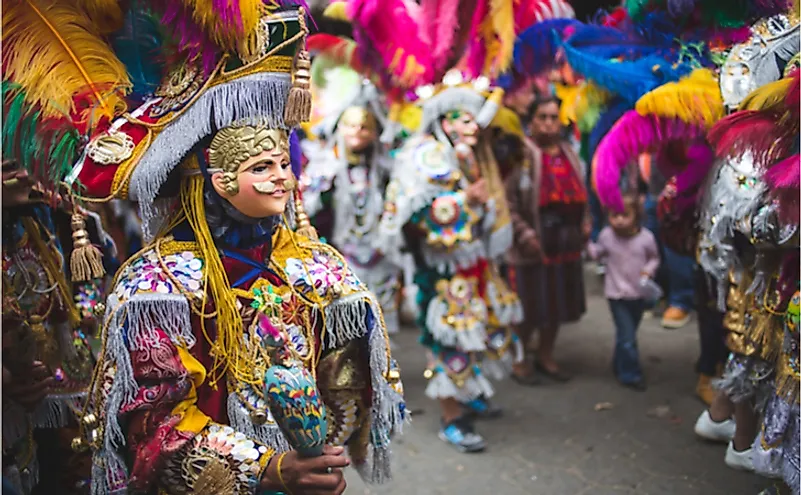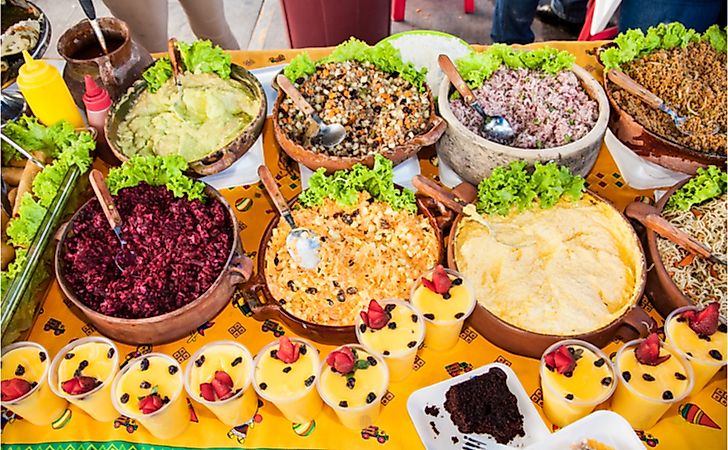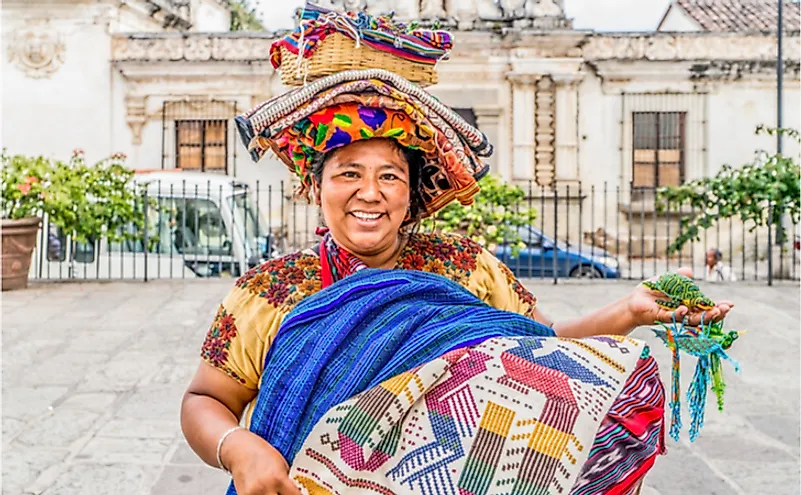The Culture Of Guatemala

The Central American country of Guatemala has a rich culture that reflects strong Spanish and Mayan influences. A great contrast can be seen between the cultures of the poverty-stricken Mayan rural residents of the country who live in the highland region and the relatively wealthy mestizos (called Ladinos in Guatemala) living in the urban areas.
6. Ethnicity, Language, And Religion In Guatemala
Guatemala is home to a population of around 16,581,273 people. Ladino or Mestizo and Europeans constitute 60.1% of the country’s population. Maya is the second largest ethnic community accounting for 39.3% of the population. Spanish is the official language of Guatemala.Mayan languages are spoken by the indigenous Maya residing in the country. Christianity is the religion of the majority. Most of the country’s Christians are Roman Catholics while a few are Protestants.
5. Guatemalan Cuisine

The traditional cuisine of the country is based on Maya and Spanish cuisines. Beans, corn, and chilies are the most common ingredients used to prepare Guatemalan dishes. Tamales are one of the most popular foods consumed in Guatemala. It is prepared by steam-cooking corn-based starchy dough wrapped in a banana leaf or corn husk. Tamales are filled with a variety of fillings like meats, cheeses, chilies, vegetables, or fruits. The wrapping of the tamale can either be used as a plate for eating or discarded prior to eating. A variety of soups and stews are also consumed. Different types of rice like fried rice, plain yellow rice, beans and rice with coconut milk, etc., are prepared and served with meat or vegetable dishes. Popular desserts of the cuisine include banana cake, rice pudding, syrup-soaked bread, etc.
4. Literature And The Arts In Guatemala

Guatemalan literary works are either in Spanish or in the indigenous languages of the people. Prior to the arrival of the Spanish in Guatemala and subsequent colonial rule, Guatemalan written literature was sparse. The country, however, had a rich tradition of oral literature. During Spanish rule, literature flourished in the country. Some the earliest works included a collection of Mayan stories and legends called the Popol Vuh. It was written in the Quiché language in the 16th century to preserve Mayan traditions. Two centuries later, it was translated to Spanish by a Dominican priest. Other works also focussed on converting oral literature to written versions. Plays, poems, and stories were also penned down by Guatemalan writers during the colonial period. Nationalist literature became prominent at the time of the Guatemalan independence movement. In the 20th century, the country's literature had matured and diversified. It was also strongly influenced by politics. The successive dictatorships and civil wars significantly shaped the country's literary works.
Guatemala also has a rich heritage of art and craft. The indigenous artists produce artwork using centuries-old pre-Columbian traditions. A large number of Guatemalan artists produce work that reflects the influences of both indigenous and foreign art traditions. Many of the country’s artists have earned fame worldwide.
Textiles woven by women on the indigenous backstrap loom are globally famous for their fine quality. A wide variety of pottery is produced and is used for utilitarian purposes or have ritualistic significance. Traditional woolen blankets of the highlands region are also well-known. Wood carvings, hand-crafted toys, beaded jewelry, leather products, etc., are also produced by the country’s craftsmen.
3. Performance Arts In Guatemala
Guatemala has a diverse scene of music. Wind and percussion bands play religious music during the Easter-week processions and Lent. The Garifuna people who settled in Guatemala’s northeastern Caribbean coast have their own folk and popular music varieties. The Maya also have their distinct musical traditions. Colombian Cumbia has earned some popularity in Guatemala. In recent times, rock music has earned a large audience in the country. Guatemalan art music has a five-centuries-old history. However, it has been revived by performers only recently. Marimba is the most commonly used folk musical instrument.
2. Sports In Guatemala
Football is Guatemala’s most popular sport. The game is played throughout the country, both professionally and informally. Although the national football team of Guatemala has not qualified for the FIFA World Cup, it has participated in 18 editions of the CONCACAF Championship. It also won the latter competition in 1919. Guatemala’s national futsal team is very successful and has participated in every FIFA Futsal World Cup since 2008. Guatemalan athletes have also taken part in every Summer Olympics since 1968. Several other sports like tennis, basketball, swimming, athletics, etc., are also played in the country.
1. Life In The Guatemalan Society
The traditional Guatemalan society is patriarchal in nature. Gender roles are well-defined. While men are regarded as the primary breadwinners, women are expected to perform household duties and nurture children. Today, however, with the spread of education among women, many Guatemalan women work outside the home. The wages earned by women are still relatively lower than that of many in many sectors of employment. In rural areas, women take part in agricultural activities and grow fruits, vegetables, spices, and herbs for local consumption and sale. Men produce export crops and major food crops that require more labor-intensive activities. In urban areas, many women work as teachers, secretaries, nurses, clerks, etc.
Although some Mayan marriages are still arranged, most marriages in the nation are based on the couple’s choice. Families might disapprove at first but eventually, give in. Sometimes, the couple elopes to tie the knot. Private schools and private clubs allow the middle and upper-class Guatemalans to mingle freely and that gives rise to many romantic relationships. Monogamous relationships are the norm. However, among the poorer sections of society, marital ties are weak and often result in the men leaving their family for a mistress. The law of the country allows the women to sue their husbands for such behavior but poorer women have little resources to fight for their cause.
Most households are nuclear in nature consisting of the couple and their children. Sometimes, the couple lives with the man’s parents after marriage until they are able to arrange for a separate home. Rich families often gift homes or apartments to their children at the time of their marriage. Inheritance is by written or oral witnessed will. In the absence of a formal will, family agreements lead to the inheritance of the dead person’s assets.
Children are brought up according to their social class. Those belonging to the higher classes are often kept under the guidance of nannies and provided with the best educational facilities. Rural children usually assist their parents in their work from an early age.
Social etiquettes vary by ethnicity. The Maya children greet adults with great respect. They bow their heads and fold their hands as a gesture of respect. Adults greet each other verbally and ask about health and family well-being. In the past, the Guatemalan society was quite class conscious. However, the situation has significantly changed now. Undercurrents of tension between the indigenous Maya and the Ladinos still exist. Despite their differences, all Guatemalans love to celebrate life and are warm and welcoming towards foreign visitors. Thus, tourism in the country is growing fast.











